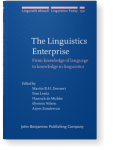The representation and processing of fixed and compositional expressions
This paper examines the way language users process so-called regular fixed expressions. Such expressions are compositional in the sense that their overall meaning can be derived from their parts, while at the same time factors such as usage frequency, resistance to modification, ‘nativelikeness’ suggest that they are stored and processed as complex lexical units, just like idioms. To test this hypothesis, we experimentally investigated the availability of regular fixed expressions for anaphoric reference as compared to fully compositional expressions. If an expression is processed as a unit, its parts will be less available, and therefore, processing anaphoric expressions should be more difficult and more time consuming compared to fully compositional expressions. The results supported this hypothesis.
Cited by (1)
Cited by one other publication
Schilperoord, Joost & Neil Cohn
2022.
Before: Unimodal Linguistics, After: Multimodal Linguistics. A Parallel Architecture Account of a Multimodal Construction.
Cognitive Semantics 8:1
► pp. 109 ff.

This list is based on CrossRef data as of 15 july 2024. Please note that it may not be complete. Sources presented here have been supplied by the respective publishers.
Any errors therein should be reported to them.
